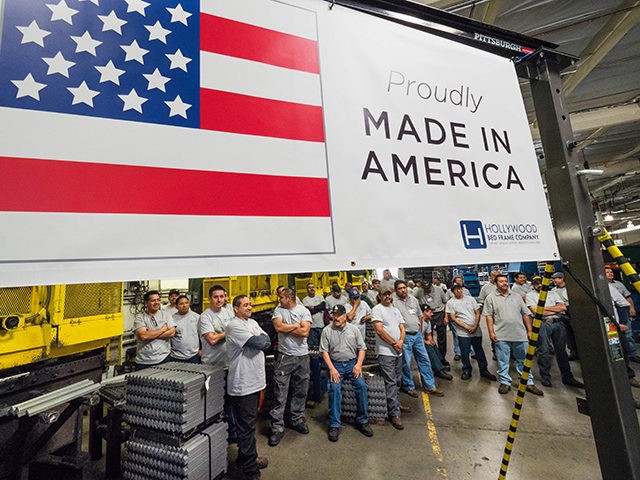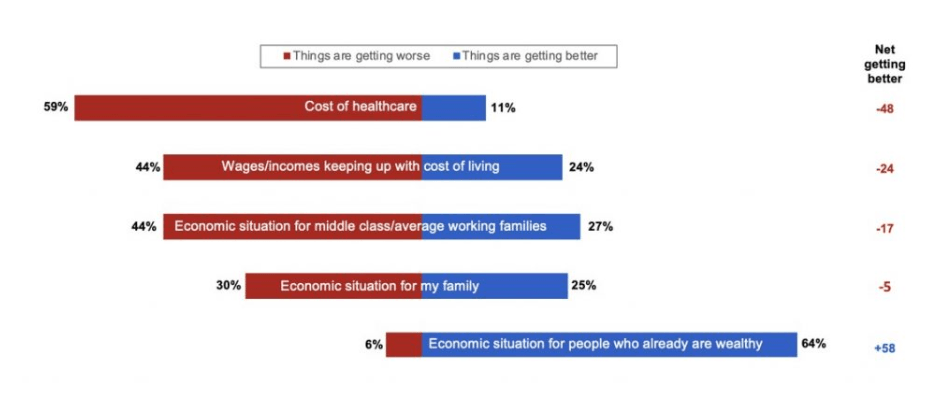President Donald Trump will lose the 2020 election because wages are not climbing fast enough, says a progressive polling group.
“Democrats will win the election if it is a fight about the economy,” says the claim by Priorities USA, a survey group.
The group is paired with one of the Democratic Party’s biggest super-PACs, Priorities USA Action, which spent $190 million in the 2016 election. Much of that sum was donated by the left-wing billionaires — including elite socialist George Soros — who favor an economic policy of high immigration and low wages.
The group is now trying to persuade Democratic donors and 2020 candidates to tout pocketbook issues such as wages and healthcare — and to downplay the demands by well-off progressive activists for easier abortion, the transgender ideology, and more regulatory curbs on the manufacturing sector. The group says their latest survey in swing states shows:
Trump is relying on the message that millions of new jobs have been created in the past few years and the stock market is at a record high. Unfortunately for him, that message fails badly (36% to 64%) when put up against the message that wages are not keeping up with the cost of living and the cost of health care is skyrocketing.
Voters just aren’t feeling what Donald Trump is selling. He constantly raves about overseeing the greatest economy ever, but that’s out of touch with the reality for many voters. Many voters see things getting worse economically on a range of key issues.
Only 38% of voters say they can pay their bills and obligations and have money to put aside for savings. Another 38% say they can pay their bills but can’t save, 17% say there are some months when they struggle to pay their bills and 7% say they are falling behind financially, falling into debt to pay their monthly bills. Among these voters, the only group that Trump currently wins are those who have enough money to pay their bills and save, the rest would support a Democrat in 2020.
The group is running pocketbook-issues ads in the critical swing states where voters are likely to reject the Democrats’ push to impose the transgender ideology on girls and boys, men and women:
However, Trump’s “Hire American” economic and immigration policy is pushing wages upwards for Americans. Wages rose almost 4 percent in 2018 and may rise 5 percent in 2019, amid inflation rates below 2 percent.
Trump’s wage growth is much faster than under President Barack Obama’s policy of importing many low-wage migrants to join the Democrats’ political coalition.
Wages are rising despite Trump’s increasing emphasis on importing skilled workers to help run the new factories and workplaces that are being created in his economic boom. In a May 16 Rose Garden speech, he toured his new 2020 immigration platform, saying:
Only 12 percent of legal immigrants are selected based on skill or based on merit. In countries like Canada, Australia, and New Zealand — and others — that number is closer to 60 and even 70 and 75 percent, in some cases.
The biggest change we make is to increase the proportion of highly skilled immigration from 12 percent to 57 percent, and we’d like to even see if we can go higher. This will bring us in line with other countries and make us globally competitive.
Trump often touts a claimed need for more foreign workers to fill new jobs, and only sometimes touts the rise in blue-collar wages allowed by his low-immigration, high-growth policies. In his Rose Garden speech, for example, he said:
Wages are rising but our current immigration system works at cross-purposes, placing downward pressure on wages for the working class, which is what we don’t want to do.
Unfortunately, the current immigration rules allow foreign workers to substitute for Americans seeking entry-level jobs. So, foreign workers are coming in and they’re taking the jobs that would normally go to American workers. America’s immigration system should bring in people who will expand opportunity for striving, low-income Americans, not to compete with those low-income Americans.
Trump summarized his 2020 campaign platform as:
Today, we are presenting a clear contrast: Democrats are proposing open borders, lower wages, and, frankly, lawless chaos. We are proposing an immigration plan that puts the jobs, wages, and safety of American workers first.
Priorities USA says their survey shows that voters want higher wages and cheaper healthcare, not more jobs for other people:
And voters largely don’t think Trump is helping. When asked how much they have personally benefited from Trump’s economic policies, 63% say just a little or not at all versus 37% who say they have benefitted some or a lot.
It is important to understand what economic pain points voters are dealing with. Of those we tested, medical expenses, the ability to save for retirement and the ability to handle an emergency top the list. Losing money in the stock market is last, reinforcing the fact that for many voters the stock market should not be considered to be a good indicator of financial well-being, and that Trump’s focus on the stock market is disconnected from voters’ every day lives.
Trump, however, is also trying to deliver cheaper healthcare to Americans. On May 21, Trump advertised his pending healthcare plan, telling a Pennsylvania TV station that “we’re coming up with a great healthcare plan that if we win back the house, keep the Senate, keep the presidency, we’re going to have fantastic health care. And the plan is coming out over the next four weeks.”
Trump did not use the TV interview to claim credit for wage raises in the state.
Priorities USA described their survey:
These findings are based on a survey of 1,600 registered votes in Florida (500 interviews), Michigan (400 interviews), Pennsylvania (400 interviews), and Wisconsin (300 interviews). The interviews were conducted online between May 1 and May 8. The samples were structured so that the completed interviews would be representative of the electorates in each state based on both demographic and political factors. The states were weighted together based on their number of electoral votes. Across the four states, the party identification of respondents is 45% Democrat and 41% Republican. Of those who report they voted in 2016, 48% say they voted for Donald Trump and 47% say they voted for Hillary Clinton.
Background numbers to know:
Each year, roughly four million young Americans join the workforce after graduating from high school or university.
But the federal government then imports about 1.1 million legal immigrants and refreshes a resident population of roughly 1.5 million white-collar visa workers — including roughly one million H-1B workers — and approximately 500,000 blue-collar visa workers.
The government also prints out more than one million work permits for foreigners, tolerates about eight million illegal workers, and does not punish companies for employing the hundreds of thousands of illegal migrants who sneak across the border or overstay their legal visas each year.
This policy of inflating the labor supply boosts economic growth for investors because it ensures that employers do not have to compete for American workers by offering higher wages and better working conditions.
This policy of flooding the market with cheap foreign white-collar graduates and blue-collar labor shifts also enormous wealth from young employees towards older investors even as it also widens wealth gaps, reduces high-tech investment, increases state and local tax burdens, and hurts children’s schools and college educations. It also pushes Americans away from high-tech careers and sidelines millions of marginalized Americans, including many who are now struggling with fentanyl addictions. The labor policy also moves business investment and wealth from the heartland to the coastal cities, explodes rents and housing costs, shrivels real estate values in the Midwest and rewards investors for creating low tech, labor-intensive workplaces.


COMMENTS
Please let us know if you're having issues with commenting.